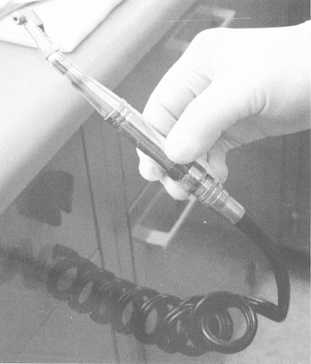
Traffic Control
Controlled access to the sterilization areas minimizes the potential for transfer of micro- organisms between contaminated items, patients, and staff.
These areas must be off limits to anyone not involved in the sterilization process.
Receiving and Cleaning
Ideally, these areas will be physically separate from the remainder of the sterilization area.
If physical separation is not obtainable, proper outfitting and equipment selection are critical.
Commands should purchase equipment that minimizes the handling of contaminated materials and instruments.
There may also be an area equipped with the utilities necessary for operating dental handpieces as shown in figure 10-2. Some commands require that the disinfection, cleaning, lubrication, and sterilization of dental handpieces take place in the CSR instead of the dental treatment room (DTR).
Check to see what your command’s policies are on where handpiece maintenance should take place.
Processing
A processing space should have ample work surface for the volume of materials processed.
All inspecting, sorting, wrapping, and packaging of contaminated materials occur here.
Sterilization
The space requirements for the sterilization process should be determined by the available size, the degree of sufficient access for the loading and unloading, and the ability to service the sterilizer.
Sterile Storage and Issue To protect and maintain all sterile items, the storage and issue areas should not be in the immediate vicinity of the contaminated processing areas.
THE STERILIZATION PROCESS
The sterilization process takes place in a CSR.
There are many benefits to the centralized approach. Centralized instrument decontamination and sterilization are usually safer and more cost effective than instrument processing in the DTR. The

Figure 10-2. Operating a dental handpiece in CSR.
Continue Reading